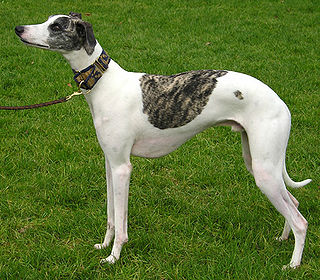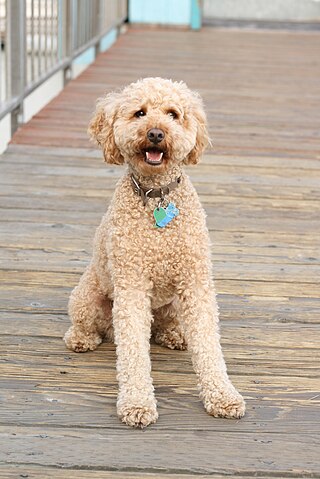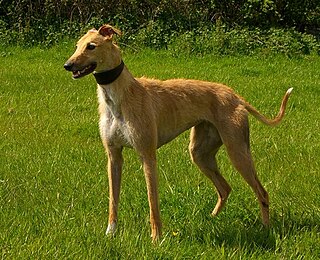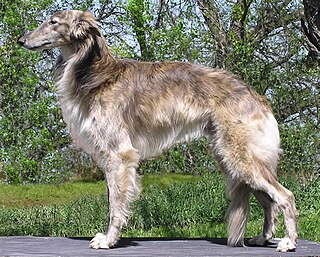
The Azawakh is a breed of dog from West Africa. With ancient origins, it is raised throughout the Sahelian zone of Mali, Niger, and Burkina Faso. This region includes the Azawagh Valley for which the breed is named. While commonly associated with the nomadic Tuareg people, the dogs are also bred and owned by other ethnic groups, such as the Peulh, Bella, and Hausa. The Azawakh is more related to the Sloughi than it is to the Saluki.

The EnglishGreyhound, or simply the Greyhound, is a breed of dog, a sighthound which has been bred for coursing, greyhound racing and hunting. Since the rise in large-scale adoption of retired racing Greyhounds, the breed has seen a resurgence in popularity as a family pet.

The Italian Greyhound or Italian Sighthound is an Italian breed of small sighthound. It was bred to hunt hare and rabbit, but is kept mostly as a companion dog.

Sighthounds are a type of hound dog that hunts primarily by sight and speed, unlike scent hounds, which rely on scent and endurance.

The Galgo Español, or Spanish Greyhound, is an ancient breed of dog, specifically a member of the sighthound family. The English greyhound is possibly a descendant of the Spanish greyhound and, for several years in the 20th century, some breeders did cross - breed Galgos and Greyhounds in order to produce faster and more powerful Galgos, specifically for track racing purposes.

The whippet is a British breed of medium-sized dog, of the sighthound type, related to the larger greyhound and the smaller Italian greyhound. Apart from the differences in height, the whippet closely resembles these two breeds; it has sometimes been described as "the poor man's greyhound". It is kept as a companion dog, for competitive showing, for amateur racing as well as lure coursing. It has the highest running-speed of any breed in its weight and size range, and may have the fastest idle-to-running acceleration of any dog.

A hound is a type of hunting dog used by hunters to track or chase prey.
Lure coursing is a sport for dogs that involves chasing a mechanically operated lure. Competition is typically limited to dogs of purebred sighthound breeds. The AKC has a pass/fail trial for all breeds called the Coursing Ability Test (CAT) and a timed 100 yard dash called Fast CAT where the dog's speed is converted to points.

The United Kennel Club (UKC) is a kennel club founded in 1898 in the United States. In contrast with the American Kennel Club, which is non-profit and which only clubs can join, the United Kennel Club is a profit-making corporation, open to individuals.

Dog crossbreeds, sometimes called designer dogs, are dogs which have been intentionally bred from two or more recognized dog breeds. They are not dogs with no purebred ancestors, but are not otherwise recognised as breeds in their own right, and do not necessarily breed true.

Coursing by humans is the pursuit of game or other animals by dogs—chiefly greyhounds and other sighthounds—catching their prey by speed, running by sight, but not by scent. Coursing was a common hunting technique, practised by the nobility, the landed and wealthy, as well as by commoners with sighthounds and lurchers. In its oldest recorded form in the Western world, as described by Arrian—it was a sport practised by all levels of society, and it remained the case until Carolingian period forest law appropriated hunting grounds, or commons, for the king, the nobility, and other landowners. It then became a formalised competition, specifically on hare in Britain, practised under rules, the Laws of the Leash'.

Hare coursing is the pursuit of hares with greyhounds and other sighthounds, which chase the hare by sight, not by scent.

A long dog is any dog of sighthound type, whether pure-bred or not. It is usually a cross-breed between two sighthounds of different breeds, one of which is usually a Greyhound It is distinct from the lurcher, which is a cross between a sighthound and a working dog, usually a terrier or herding dog. And it is generally larger than a feist, which is an American cross.

A feist is a small hunting dog. This group descended from the terriers brought over to the United States by British miners and other immigrants. These terriers probably included crosses between the Smooth Fox Terrier, the Manchester Terrier, and the now-extinct English White Terrier. These dogs were used as ratters, and gambling on their prowess in killing rats was a favorite hobby of their owners. Some of these dogs have been crossed with Greyhounds, Whippets or Italian Greyhounds, and Beagles or other hounds — extending the family to include a larger variety of purpose than the original ratter, or Rat Terrier.

The Silken Windhound is an American breed of sighthound. Like most sighthounds, Silkens are noted coursers.

The Magyar agár (MA) is a dog breed. It is a type of sighthound originating in Hungary and lands that previously belonged to the Austro-Hungarian Empire. It is used for hunting and coursing, and is also kept as a companion.

The kangaroo dog or kangaroo hound is an Australian type of sighthound purposely crossbred from a variety of sighthound breeds to produce a hunting dog.
The Old Croatian Sighthound, also known as the Old Bosnian Sighthound, is an extinct breed of sighthound from the countries of Bosnia–Herzegovina and Croatia.

The American Staghound, referred to by various names including the Cold-Blooded Greyhound, the Longdog of the Prairie and the American Lurcher, is a crossbreed of various sighthounds. It has been bred in the United States from the 19th century where it is used for hunting.


















